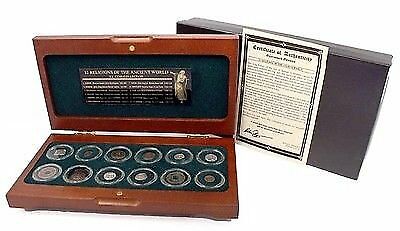-40%
Pontius Pilate Coin Bronze Prutah. Certified Authentic.
$ 73.91
- Description
- Size Guide
Description
Pontius Pilate Coin Bronze Prutah. Certified Authentic.A Bronze Prutah Coin Of Pontius Pilate. He Is Most Famous For Presiding At The Trial Of Jesus Christ Of Nazareth And Sentencing Him To Die By Crucifixion, An Event That Was Destined To Fundamentally Alter The Course Of Human History. Each coin comes in a deluxe portfolio album with a certification of authenticity and coin information.
Pontius Pilate was a Roman governor, or prefect, from 26 to 36 C.E. He issued a small number of bronze prutah coins during a three year period. He is most famous for presiding at the trial of Jesus Christ of Nazareth and sentencing him to die by crucifixion, an event that was destined to fundamentally alter the course of human history. To this day, 2000 years later, the ongoing significance of that event cannot be overstated. While we are certain about his coins, other aspects of Pontius Pilate’s legacy are less well known.
For most of two millennia historians and theologians have debated the facts of Pontius Pilate's actions, words, motivations and sentiments during his tenure as governor, especially the exact extent of Pilate's role and his level of responsibility for Jesus' condemnation. Was Pilate’s actions a result of coercion, legal requirements, or was he a malicious and willing participant in the persecution of Jesus? The countless historical written accounts portray Pilate from conflicting points of view. Certainly Pilate had the authority as Prefect to do with Jesus as he wished. Among Pilate's detractors, Philo of Alexandria was not alone in vilifying Pilate in his writings, where Pilate is described as
"…inflexible, stubborn, of cruel disposition. He executed troublemakers without a trial."
Philo refers to Pilate's
"venality, his violence, thefts, assaults, abusive behavior, endless executions, endless savage ferocity."
In stark contrast, according to all the Gospel accounts, Pilate hesitated to condemn Jesus, but eventually was forced to give in when the crowd insisted, and the Jewish leaders reminded him that Jesus' claim to be king was a challenge to Roman authority.
Early Christian texts did their best to exonerate Pilate from responsibility for the death of Jesus. The author of the text known as the
Didascalia Apostolorum
(5.19.4) states that Pilate did not agree with Jesus' guilt; he symbolically “washed his hands� of the verdict. The Christian author Eusebius thought that the former governor felt remorse for the execution of Jesus (
History of the Church
, 2.7.1). St Augustine classified Pilate among the prophets in one of his sermons (#201). In his
Apologeticum
, the ancient church father Tertullian thought that Pilate was a Christian at heart. Pilate's wife, Claudia Procula was canonized as a saint in the Greek Orthodox Church due to her role in trying to save Christ from condemnation.
One unverified account describes Pilate being summoned to Rome by the Emperor Caligula. There, Pilate was reportedly dismissed for his alleged excesses and exiled to Gaul, where he is thought to have committed suicide in Vienne. We may never know what actually happened to Pilate after his dismissal. The Ethiopian Church, however, thinks that Pilate became a Christian and was martyred. Those Christians canonized the governor of Judaea, whose Saint's day is June 25.
Pontius Pilate's bronze prutahs of Judaea were minted in years 29, 30 and 31 C.E., in Jerusalem, at the point in time and the place where Jesus spent his last days. The coins circulated in the Holy Land during those events 2000 years ago. Pilate minted two coin designs with distinctive images: (1) The earlier type shows a simpulum, a utensil with shaft and a handle used by Roman priests to ladle wine onto ritual animal sacrifices. Reverse shows three ears of barley. (2) The later type shows a Roman lituus, the curved wooden staff held upward by
augurs
, religious men that invoked the gods and made predictions. The reverse side shows a wreath, a symbol of power and victory, found on ancient Greek, Roman and also modern coins. Greek inscriptions refer to Roman emperor Tiberius and Empress Julia. All Judaean bronze coins were crudely minted. Most surviving coins of this era are odd shaped and show only partial inscriptions









